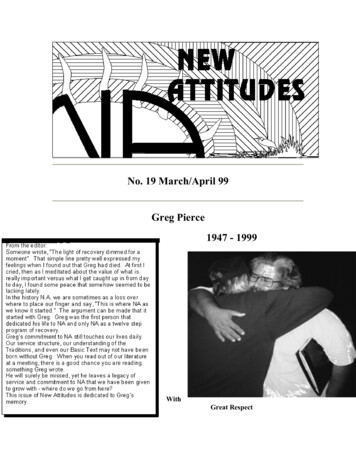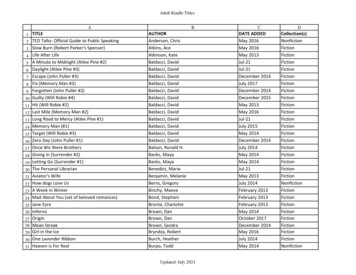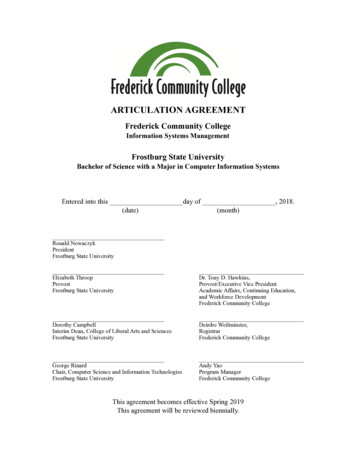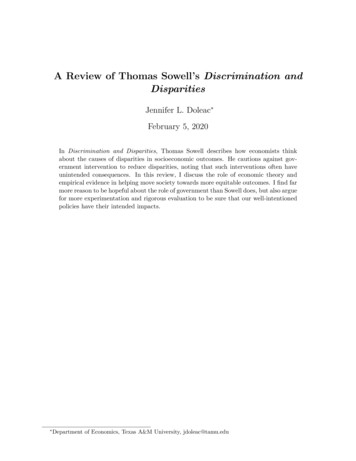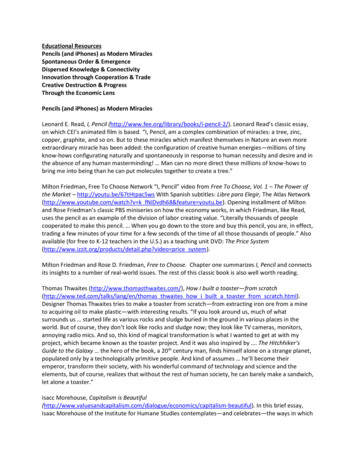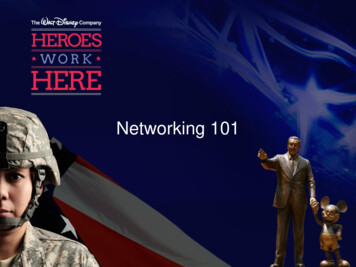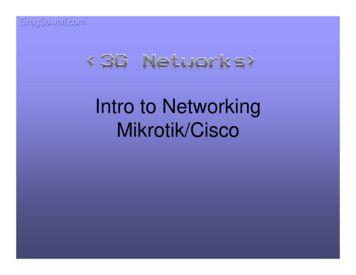
Transcription
GregSowell.comGregSowell.comIntro to NetworkingMikrotik/Cisco
GregSowell.comGregSowell.comTerms Used Layer X – When I refer to something being at layer X I’mreferring to the OSI model. VLAN – 802.1Q Layer 2 marking on traffic used tosegment sets of traffic. VLAN tags are applied onaccess ports. Trunk – I’m referring to an 802.1Q trunk port. This is amethod to transmit frames across an L2 link with a VLANtag intact. Outside/Inside – Outside refers to the interfaceconnecting you to the Internet where as Inside refers tothe interface connecting you to the LAN side of yourrouter. I’ll use these terms most often when talkingabout NAT.
GregSowell.comGregSowell.com NAT/PAT – Network Address Translation. Thistake a private address (RFC1918) andtranslates it to a publically routable IP. PortAddress Translation is a method to translatemultiple private addresses to a single public IP(masquerade). DHCP – Dynamic Host Configuration Protocol –Auto assign IP on hosts. TCP port 67. NTP – Network Time Protocol. Synchronizesyour system time to an external time server. Bridging – Refers to layer 2 connectivitybetween multiple ports.
GregSowell.comGregSowell.comOSI Model - 7 LayersDecapsulationEncapsulation 7 – Application – Interact directly with Apps(FTP, HTTP, SMTP) 6 – Presentation – Formats data (encryption) 5 – Session – Controls connections betweencomputers 4 – Transport – TCP/UDP – ports - Segment 3 – Network – IP addressing - Packet 2 – Data Link – MAC addressing - Frame 1 – Physical - Electricity
GregSowell.comGregSowell.comL7 - Application HTTP.SNMP.SMTP.Interacts directly with your applications.
GregSowell.comGregSowell.comL6 - Presentation Encoding. Encryption.
GregSowell.comGregSowell.comL5 - Session Manages connections between local andremote applications. Not usually used in the IP suite.
GregSowell.comGregSowell.comL4 – Transport TCP/UDP live here. Connection and connectionless orientedtraffic. Use ports to keep track of conversations. PDU at this level is a Segment.
GregSowell.comGregSowell.comTCP Connection oriented – reliable. FTP, SMTP, HTTP. Flow control – how much traffic can the receiving endhandle. Window size – how many packets can be receivedbefore an acknowledgement (ACK) must be sent. 3-way handshake –––––SYN SYN ACK ACK *We are now established*
GregSowell.comGregSowell.comUDP Connection less – best effort. TFTP, RTP.
GregSowell.comGregSowell.comTCP vs UDP Sequenced - UnsequencedReliable - UnreliableConnection-oriented - ConnectionlessVirtual Circuit - Low overheadAcks - No Ackswindowing/flow control - None
GregSowell.comGregSowell.comL3 - Network IP addressing.Connects LAN segments.Protocol numbers are L3 facilities.PDU at this level is Packet.
GregSowell.comGregSowell.comProtocols 1 - ICMP6 - TCP17 - UDP47 - GRE50 - ESP51 - AH112 - VRRP115 - L2TPDon't confuse UDP/TCP ports with protocolnumbers.
GregSowell.comGregSowell.comL2 – Data Link MAC addressing – Media Access Control. ARP – Address Resolution Protocoloperates at this level. This is an IP toMAC lookup process. Though L3 usesthis, ARP has no protocol number.
GregSowell.comGregSowell.comL1 - Physical Where our frame is transferred toelectricity and sent across a wire. Covers cabling types. This is as high as hubs go in the OSImodel.
GregSowell.comGregSowell.comSwitch Vs Hub Layer 2 – Layer 1. Full Duplex (4 wires) – Half duplex (2wires). Every port single collision domain – 1 bigcollision domain *both have singlebroadcast domain*. Not needed – CSMA/CD (Carrier SenseMulti Access. Switch good – Hub bad.
GregSowell.comGregSowell.comBridging/Switching Bridges were introduced to connect LAN segments in hubenvironments. They were generally 2 port guys. Software baseddevices. Broke the hub network’s collision domains up.Switches came along which are pretty much multi port bridges.Bridges are usually implemented in software where as switches aregenerally hardware based devices. Switches include ASICs(Application Specific Integrated Circuits) that do the switching.In Mikrotik when you create a bridge interface and add ports, this isall done in software, which is why the CPU takes a performance hitin heavy bridging operations. Some models like the RB450s andthe RB750 have some switching ASICs which is why you get wirespeed performance when using this ports configured properly.Cisco has been ASIC based since they bought the Catalyist seriesswitches.
GregSowell.comGregSowell.comCabling Straight through – Host to Switch. Cross over – Switch to Switch or Host toHost. Hosts are routers and PCs. MDI/MDI-X is sometimes employed whichis an “auto crossover” technology. Itsenses whether or not the cable needs tobe crossed.
GregSowell.comGregSowell.comType A or B Standard
GregSowell.comGregSowell.com100Mb Crossover
GregSowell.comGregSowell.com1Gb Crossover Type-A
GregSowell.comGregSowell.comCisco 3 Layer Model This is more of a legacy design, but you may still run intoit. Core – Switched only – high speed! Distribution – Routing – traffic decisions are made here. Access – User connections – Traffic marking. This is a Cisco specific model, though Mikrotik isattempting to move to this very design. Cisco has longhad Fast switching and CEF, where as MTK has doneeverything in CPU with no optimizations. With theadvent of MPLS integration in the MTK OS, they wantyou to enable this and basically do a form of switchingacross your core to speed performance.
GregSowell.comGregSowell.comIP Addressing - The Post Office The aggregate network your IP addressresides in is like your zip code, it gets themail to the right post office. The network portion of your IP addresssorts the mail at the post office to the righttruck. The host portion of your IP address getsthe mail to your mail box.
GregSowell.comGregSowell.comIP Address Classes There are 5 classes, A – EA is 0.0.0.0 - 127.255.255.255B is 128.0.0.0 - 191.255.255.255C is 192.0.0.0 - 223.255.255.255D is 224.0.0.0 - 239.255.255.255 - MulticastE is 240.0.0.0 - 255.255.255.254 - Experimental
GregSowell.comGregSowell.comSpecial Addressing RFC1918 addressing is private, noninternet routable address space.– 10.0.0.0/8– 172.16.0.0/12– 192.168.0.0/16 127.0.0.1 is the IPv4 loopback address .
GregSowell.comGregSowell.comIP Address Structure Example IP is 192.168.0.1 255.255.255.0Network portion is 192.168.0Host portion is .1Subnet mask is 255.255.255.0Network portion is determined by thesubnet mask.
GregSowell.comGregSowell.comHow to Subnet My favorite book example, and the way Ilearned was via Todd Lammle’s SybexCCNA book. http://www.learntosubnet.com/ /1022445898/index html http://www.speedguide.net/read articles.php?id 1883
GregSowell.comGregSowell.comSubnetting in Your HeadYour Fingers are Your Friends How to determine subnet size– How many hosts do we need in oursubnet? Remember we lose 2 IP addresses persubnet; one for network and one forbroadcast.– How many different subnets do weneed?
GregSowell.comGregSowell.comNetmask Memorization Chart Subnet Values -128192224240248252254-Number of IPs128643216842- # of bits to add to the default subnet mask-1234567You have to memorize the subnet values this is unavoidable. The trick is tocount these on your fingers as you go. If you can remember that the subnetvalue and number of IPs both start at 128, then you are golden. As youcount your fingers, divide the number of IPs in half. Once you get to thenumber you want, recount to the same finger by the subnet values.
GregSowell.comGregSowell.comFinger-sub Example 1 Host network is 10.0.0.0/8 or 255.0.0.0 I need a small subnet that only has 28 users. Lets find our subnet mask by counting on ourfingers. Finger 1 is 128, finger 2 is 64, finger 3 is32, finger 4 is 16. That means we stop at finger3 because we need at least 28 IP addresses. So, starting from finger 1 we count our subnets:finger 1is128, finger 2 is 192, finger 3 is 224.Our subnet mask will be 255.255.255.224.
GregSowell.comGregSowell.comMore Subnetting Terms VLSM – Variable Length Subnet Mask. Thisgenerally refers to subnetting a network addressbeyond it’s classful boundary. CIDR – Classless Inter-Domain Routing. Usesthe same concepts as VLSM to aggregatenetworks into non-classfull blocks. Subnet Zero – Cisco says subnet zero is "If anetwork address is subnetted, the first subnetobtained after subnetting the network address iscalled subnet zero." The command to allow thisbehavior is "ip subnet-zero". This command hasbeen default for ages in IOS.
GregSowell.comGregSowell.comSwitching The basic function of a switch is to provideethernet connectivity for a LAN segment. Switches build a MAC address table(Cisco it’s called a CAM-ContentAddressable Memory) dynamically.
GregSowell.comGregSowell.comMAC Learning Process
GregSowell.comGregSowell.comSTP – Spanning Tree Protocol Another important switching function is loop avoidance. This is generallydone with STP.802.1D was the original STP version. Ratified in 1998. 5 STP states:disabled, blocking, listening, learning, forwarding. In 2004, 802.1D-2004was released that replace the legacy STP with RSTP.802.1W RSTP – Rapid STP. This runs a single instance per link. RSTPstandardized Cisco features such as port fast/backbone fast/uplink fast. 3STP state: discarding, learning, forwarding. There are 3 link types:Point-2point(connects to another switch – designated as p2p when a BPDU isreceived), Shared(connects to a hub) and Edge(connects to singe host –designated with portfast command in Cisco).Port Roles– Legacy STP Rapid ST Root Root –Port that leads to root bridge. Designated Designated – Port that leads downstream and is forwarding. Blocking Alternate – Alternate root port that is in blocking state, waiting for root portto fail so it can quickly transition to root port. Blocking Backup – Backup downstream port that is in blocking, waiting fordesignated port to fail so it can quickly transition to designated port. 802.1S MST – Multiple ST – What this does is allow you to run multipleinstances of STP on a single link. You specify which VLANs are membersof which MST instance. This way you can loadbalance your STP traffic.
GregSowell.comGregSowell.comVLANs A VLAN is a method to tag traffic at L2. VLANs allow you to segment L2 traffic inside of a singleswitch or among a switched infrastructure. 802.1Q is the standards based VLAN trunking protocol. Trunking is a method to transfer tagged traffic from oneswitch to another while maintaining the VLAN tag on apacket. 802.1Q adds a field to the L2 ethernet frame, where asthe Cisco proprietary ISL trunking protocol actuallyencapsulates the frame. Cisco switchport mode trunk Tagged packets have the VLAN tag. Trunk Ports. Untagged packets have the VLAN tag stripped off.Access Ports. Cisco switchport mode access
GregSowell.comGregSowell.comRouting A router’s basic job is to connect one LANsegment to another. Every port on a router breaks up collisiondomains and broadcast domains. Nobroadcast traffic is routed by default. Uses route table to determine how tomove traffic.
GregSowell.comGregSowell.comRoute Process
GregSowell.comGregSowell.comBuilding Route Table Static routes or dynamic routing protocols– Static routes become cumbersome tomaintain in large deployments.– Dynamics(RIP, OSPF, BGP, EIGRP) scale forlarger deployments. These are dynamicrouting protocols. TCP/UDP are examples ofrouted protocols. Default route says, if you don’t matchanything else, go this direction.
GregSowell.comGregSowell.comRIP – Routing Information Protocol RIP – Distance vector (hop count) –Bellman-ford algorithm. Inefficientbroadcasts, send all routes every 30seconds. 15 hop limitation. Classful. RIP V2 – Distance Vector. Uses multicastto distribute routes. 15 hop limitation.Classless.
GregSowell.comGregSowell.comOSPF – Open Shortest Path First Standards based.Link State protocolConcept of areas. Areas optimize route distribution and add stabilityMaintains an LSDB( Link State Database) of all connections within an area.All routers know all paths from all routers in same area. Allows each routerto run the SPF calculation to find the best routes to install in their routetable.Area 0 is the backbone area and all routers must traverse this area to reachany other area.Classless.Dijkstra algorithm.Uses protocol # 89 to transfer routing info.Uses DR and BDR on broadcast networks. Designated router receivesupdates from all other routers in area, then relays updates to all neighbors.Backup DR is poised to take the DRs place on failure.Maintains a neighbor or adjacency table. Routers that share the samesubnet that are in at least a two-way state are considered neighbors.Uses Hellos for neighbor establishment and keep alives. High speed linksdefault to 10 second hellos and dead timer at 40 seconds. Slow linksdefault to 30 second hellos and 120 second dead timers.
GregSowell.comGregSowell.comOSPF Router Types Backbone router – Only in area 0. Area Border Router – Has interfaces inthe backbone area and another area. ASBR – Has a connection that leadsoutside of the OSPF domain (Ex.connection to ISP).
GregSowell.comGregSowell.comOSPF LSA Types LSA stands for Link State Advertisement. This is howOSPF relays topology information between neighbors. Type 1 – Generated by all routers. Lists router’sneighbors and the cost to reach them. Type 2 – Generated only by DR. Lists all neighbors on asegment. Type 3 – Generated by ABR. Summary LSA. Stripstopology info of the type 1/2 LSA. Sends prefix with costinto other areas. Type 4 – Generated by ASBR. ASBR summary.Created to give cost info to reach ASBR. Type 5 – Generated by ASBR. Used to advertiseexternal routes. Type 7 – Generated by ASBR in a NSSA.
GregSowell.comGregSowell.comArea Types Standard Stubby – LSA type 5’s are removed and a default routeis sent. Totally Stubby – LSA type 5 and 3 are removed anddefault is sent. Not So Stubby – LSA type 5s are blocked from enteringarea. If an ASBR is contained within the NSSA, insteadof creating type 5 LSAs, it creates type 7 and are floodedthroughout the area. When the type 7 hits an ABR, it isconverted to a type 5 and sent to other areas toredistribute the external routes. Totally NSSA – Type 7s just like NSSA, only type 3s areblocked also.
GregSowell.comGregSowell.comMisc OSPF Network command does not tell OSPF what toadvertise, rather it tells OSPF what interfaces toput in the OSPF process. You can alternatelyuse the OSPF interface command in lieu of thenetwork command. Passive interface is an interface that doesn’tparticipate in the process. Summarization can only be done at areaboundaries. Virtual links can be used to transit a nonbackbone area.
GregSowell.comGregSowell.comOSPF Troubleshooting Make sure that metrics match: timers,authentication, area, main subnet, whethera DR is elected or not, area type(stubby,NSSA). Technically MTU isn’t part of themetrics that must match, but in Cisco, ifthey don’t match your neighbors generallywon’t pass LSAs properly.
GregSowell.comGregSowell.comIGRP – EIGRP Cisco proprietary.Advanced Distance-vector or hybrid.Uses DUAL – Diffusing Update Algorithm.Neighbor table – contains neighbors.Topology table – contains routes from allneighbors. Metrics include – Bandwidth, Delay, Reliability,Load, MTU – Bandwidth/Delay are used bydefault. Cisco recommends not using the othermetrics.
GregSowell.comGregSowell.comBGP Border Gateway ProtocolThis is the protocol the internet runs on.Built for stability.Path Vector.Uses Path Attributes to determine best route.The default PA is Autonomous system path(AS PATH). Path refersto AS sequence.Forms neighbors via TCP port 179.Default hello interval is 60 seconds, default dead time is 180seconds.Internal BGP neighbors iBGP is a neighbor in same AS.External BGP neighbors eBGP is a neighbor in a different AS.
GregSowell.comGregSowell.comBGP Neighbors TCP connection request must be sourcedfrom and address in a neighbor statement. AS must match neighbor reference. Router IDs can’t be the same. Authentication must match (Cisco onlysupports MD5). BGP Open messages include thekeepalive timer value. If they mismatch,they use the lowest value.
GregSowell.comGregSowell.comBGP NLRI The BGP topology table, also referred toas the BGP Routing Information Baseholds Network Layer ReachabilityInformation (NLRI). NLRI is an IP prefix and a prefix length. BGP does not technically advertise routes,rather it advertises Path Attributes alongwith NLRI that shares that same PA.
GregSowell.comGregSowell.comRoute Table Decision Tree Next hop must be reachable.Use Shortest AS path.Prefer eBGP or iBGP.Lowest IGP metric to next hop.Choose BGP route with lowest Router ID.
GregSowell.comGregSowell.comRoute Advertising When sending to eBGP peer, next hop isset to eBGP router.– Can be changed with Cisco next-hop-unchanged Mikrotik “nexthop choice” propogate When sending to iBGP peer, next hop infois left intact.– Can be changed with Cisco next-hop-self Mikrotik “nexthop choice” force self
GregSowell.comGregSowell.comRoute Reflection iBGP peers by default won’t advertiseroutes learned via other iBGP peers. A fullmesh is required in iBGP. Route Reflection is a way around that. Ifyou have a stub peer, you can make it aroute reflector client, and the routereflector server will advertise all iBGProutes to and from this peer to all of itspeers.
GregSowell.comGregSowell.comRR Continued
GregSowell.comGregSowell.comNAT Network Address Translation. This conserves public IP addressing. This allows two organizations that have overlappingaddress space to merge. Take an IP or pool of IPs and translate their address to anew IP or pool of IP addresses. Types:– Static – This is your 1 to 1 natting. Single IP to single IP orsingle port to single port.– Dynamic – This is a pool of IP address natted to another pool ofIPs. This would be when two orgs combine and haveoverlapping IP or if you have enough publics to hand a singlepublic to a pool of addresses.– Overload or Masquerade. This is really PAT or Port AddressTranslation. Port Address Translation is a method to translatemultiple private addresses to a single public IP.
GregSowell.comGregSowell.comNAT
GregSowell.comGregSowell.comBasic Diagram
GregSowell.comGregSowell.comBasic Diagram 2
GregSowell.comGregSowell.comBasic Diagram 3
GregSowell.comGregSowell.comBasic Diagram 4
GregSowell.comGregSowell.comBasic Diagram 5
beyond it's classful boundary. CIDR - Classless Inter-Domain Routing. Uses the same concepts as VLSM to aggregate networks into non-classfull blocks. Subnet Zero - Cisco says subnet zero is "If a network address is subnetted, the first subnet obtained after subnetting the network address is called subnet zero." The command to .

